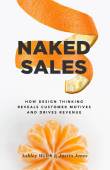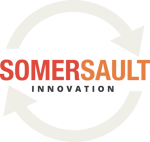Think sales and design have nothing in common? Think again.
Ashley Welch and Justin Jones, the co-authors of Naked Sales and co-founders of Somersault Innovation, teach you how to incorporate design thinking into your sales strategy to develop deeper relationships with your customers. So deep, in fact, that they will never want to stop working with you.
Whether you work on an inside sales team or with a group of field reps with multimillion-dollar portfolios, this episode of Author Hour will change the way you do business forever.
Key Points From This Episode:
- The four curiosity prompts that salespeople can practice
- The value of simply asking, “What is the bane of your existence?”
- How to put what the customer cares about before the sale

How has Naked Sales helped your clients boost their sales?
We just finished working with three different teams, each team was about 12 people, and at the end of working with the three teams, we had them report on their results of working with us over the last three months. Across those three teams, the sales pipeline for them increased by 15 million dollars.

Those are pretty significant results on their own, but this also happened during summer months when they typically see their pipeline go down.
So, not only did they gain revenue but by implementing what we’ve outlined in Naked Sales, these teams were able to create an environment of stability during a time when sales were typically very unstable.
Another example I can share involves 33 sales reps that we work with. For this particular company, we always measure what happens in the accounts that these sales reps are working on.
With a group of 33 reps and 66 accounts, their sales pipeline went up 120% over three months.
We then measured what happened to annual contract value over six months, and found that the revenue had gone up by an astounding 170%, adding millions of dollars to their top line.
The results have been pretty phenomenal and I think we’re correct in stating that no team has achieved anything less than a 100% increase in their pipeline when they work through our process with us.
What kind of sales teams do you work with?
Some of them are enterprise sales leaders, which means they only have one or two big multi-million dollar accounts, but other teams focus on much smaller tier accounts and their average account deal may be around 150,000 dollars versus over 1 million dollars.
We also work with inside sales reps who are the ones really dialling for dollars. They don’t have a large revenue charter or no revenue target at all, but they may have a number of touches or people that will respond to them to meet their quotas.
It runs the gamut from enterprise sales to inside sales.
In addition to the size of the account, a sales professional might be leading or managing a sales team. So, we’ve also worked with people at all different stages of the sales process and with different histories in terms of how long they’ve been doing sales.
Some people we work with are at the very initial stages of the sales process; they’re cold calling just to generate some initial interest. Others are at the back end managing relationships and moving transactions across the finish line.
We’ve seen very strong results with our methods for each of these categories of sales or account professionals.
Lastly, we also work across verticals. We may work with professionals focused on health and life sciences, retail, or any number of other
industries. If you’re involved in any kind of sales, our methods can help you.
What’s the #1 takeaway from Naked Sales?
We need to strip away all the complexity that is inherent in today’s sales cycle and get it down to its essential human quality, which is focusing on your clients.
As someone in sales, it’s your job to understand what problem your clients are trying to solve and ideally, you should even connect with your client’s customers so that you really understand their business at a fundamental level.
Your client’s customer is the one stakeholder that everybody should care about. You can reduce everything to its simplest form, which I think design helps you do, by focusing on the people that drive and generate value. After that, everything else falls into place.
Focus on what your customer cares about and focus on what your customer’s customer cares about.
Use that information to start a conversation and build a deeper relationship with your client.
What we say is, forget about what you’re selling for a moment, go do some deep discovery on what your client cares about and what your client’s customers care about and use that information to start a different kind of conversation around value.

It’s a very authentic, real conversation about something the client actually cares about versus talking only about your products and services.
What are the four “Curiosity Prompts” discussed in Naked Sales?
Curiosity prompts are very helpful, small things that salespeople can practice noticing. The great thing about these prompts is that they’re everywhere. There are plenty of opportunities to practice using them.
In every interaction, one or more of these curiosity prompts are present, but we typically have an agenda that might make us blind to them.
Often times we’re already thinking about how we can best position our product or service before we even walk into the meeting room or jump on the call with a client. Because of this singular focus, we miss these really interesting moments that happen when we interact with clients.
To an extent, we can get better at seeing these prompts and using them to steer the conversation organically.
Fundamentally, curiosity prompts make interactions very authentic. It’s instantaneous authenticity. They allow you to build rapport and they open the dialogue to invite clients to share more about what’s going on in their business, what’s important to them, and why.
Each of the four prompts involves anything that catches you as surprising or anything that’s unexpected that comes up in the conversation.
Typically if something surprising or unexpected comes up in a conversation we, as salespeople, tend to ignore that. We don’t talk about surprising things because we like to stick to our agenda. We have to make sure we hit all of our key points in order to drive the sale forward.
But in the process you end up brushing past these really interesting, surprising things that come up and in so doing, you miss an opportunity to learn from the client.
The four prompts we teach people to look out for are:
- What surprises you? What comes across as unexpected or atypical?
- Where do your clients place value? Has that changed since the last time you spoke with them?
- What are there hacks or workarounds that your client is using? Where are people trying to get around the system to make it work for them?
- Where do you see inconsistencies? When has your client said one thing but done something else?

In any four of those instances, that’s a great place for you to double down and ask more instead of just moving on.
What’s does a typical Naked Sales conversation sound like?
Let me give you an example.
We had an account executive who was having a really hard time getting a conversation going with Starbucks. Finally, he decided to go and visit a Starbucks store after hours and was chatting up the manager about some pain points.

Eventually, he asked the manager, “What’s the bane of your existence in your role here as a store manager?” And she responded, “The milk binder.” That surprised him because Starbucks is very much seen as a purveyor and seller of coffee, but she was focused on milk.
Instead of just kind of brushing that to the side and keeping the conversation on his agenda, he said “Wow, that surprises me, I wouldn’t have expected you to say that. Can you tell me about this binder?”
She brings it out, it’s a thick binder, plops it on the counter, and then she starts paging through soy milk, skim milk, 2% milk, and so on. At the same time, she’s explainings how each different type of milk has a different process and that they have these work around’s for managing varieties, temperature, storage, expiration dates, and it’s really painful.
After that meeting, he sends an email off to the CIO saying, “Hey, I hear the milk binder could use some innovation” and he gets a meeting with the CIO of Starbucks. The main takeaway is that big things can come from these really small, almost micro-interactions, but only if you’re paying attention.
How can we, as salespeople, add value to our customers?
What do people care about? Let’s use a mortgage company as an example, an account executive we were working with went to a mortgage company and literally just asked them, “What do you care about?”
The mortgage company said, “We care about timely, validated disclosures. Because if we can get a validated disclosure, we can move the mortgage process along more quickly and satisfy our customers. But when they’re held up, that causes problems for all of us.”
The account executive knew that if their software could help them get validated disclosures faster, he could really help solve a real problem for his client.
So many of these things are so simple and yet they get lost in the complexity of all the things we think we’re supposed to know and all the information we have at our fingertips.
The third curiosity prompt is all about hacks. How do you notice when your clients are looking for shortcuts?
One of the best ways to notice workarounds is to get your clients to give you a tour of their office, building, or acility. Or you can ask them to show you have they actually carry out a specific process.
Let’s say you’re interested in how your client forecasts, well, you could simply say, “Can you actually show me how you forecast?”
And this is a real example, we had someone go to a client and ask them a very similar question about loans, well the client pulled up their own loan spreadsheet in Excel and the salesperson said, “Wait a second, you created your own software essentially, or your own process, because your current system doesn’t work for you?” And they said, “Yeah, and this one works great for us.”

So that’s a hack.
A hack is a great clue that your client has an unmet need that you may want to pursue further. Bring the hack up in conversation and figure out what it is the client actually wants.
One other point to make is that we’re not always suggesting that there is going to be a direct link between a hack and what you offer as a product or service.
What we suggesting is that by being open to these curiosity prompts you’re allowing yourself to have a very authentic conversation with your client about what they care about. That can then lead you a much bigger conversation regarding an opportunity to work together by starting with something that is authentic and real for them. It’s all about nurturing relationships.
How can we use our client’s inconsistencies to our advantage as salespeople?
When somebody says one thing but then does the opposite, or when they say something is a priority but they are haven’t funded it, that’s when you should be paying attention.
Inconsistencies, like all other curiosity prompts, are a way to start a conversation with your clients. Prompts aren’t designed to help you close deals more quickly with desperate customers; prompts make you a better problem finder.
They increase the likelihood that you will discover even more issues. When you know your client’s business better than they do, that’s when you’ll start having bigger and better conversations with your client. That’s when you’ll be able to start building a deeper rapport with your clients.
What transformations have clients seen once they’ve started using the curiosity prompts?
I’ve already mentioned some of the dollar-figure increases that we’ve seen, and that’s incredibly important because we work in sales, so we’re naturally very motivated by the numbers, but we’ve also seen some really interesting qualitative or experiential shifts in the people that we’ve worked with.
Certainly for people who are a bit newer to sales they’ve come back to us and told us that they’re feeling more confident and authentic more quickly.
Many salespeople come fresh out of some on-boarding training program and they’re given scripts which makes them feel very mechanical, and they don’t like it. After working with us and adopting our methodology, they feel like they can show up as themselves, be genuinely curious and engaged, and have a great time.
For our more tenured professionals, people who have been in the business for decades, it’s really exciting to see them having fun again. They know their products and they know their services very well, they know their clients as well as their industry verticals, and over time that can get quite monotonous, especially when things tend to stay the same.
After working with us, people talk about feeling like they did years ago when they first started. That’s also really exciting to see.
What’s one challenge you can give people this week to help them in their sales role?
I’d love to offer one challenge, and it’s this:
Next time you’re on a sales call, ask one more “why.” Don’t make it complicated, just ask one more “why.”
It could be as simple as, “Why do you do that? Tell me why that’s important to you.”
Ask why one more time than you’re actually comfortable doing and see what happens. Because you’re going to see, it’s going to change your life. Do that at home and do it with your customer.
Secondly, I would like for you, as a salesperson, to find a way to see your client the way their customers do. Whether that means buying their product online or in a store or going out and talking with actual customers and hearing about how your client adds value to their lives.
That is a powerful perspective that most of your competitors won’t bring to the conversation. Talk to your customer’s customer.






